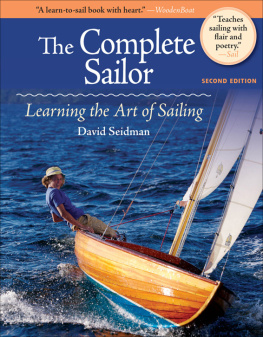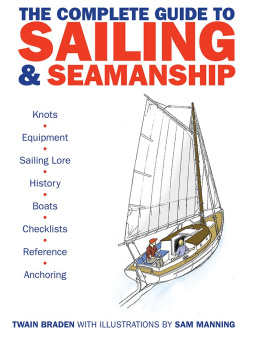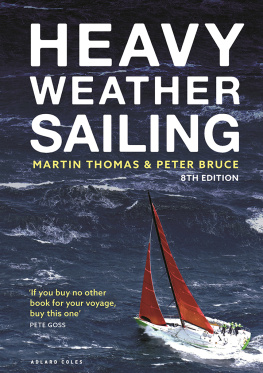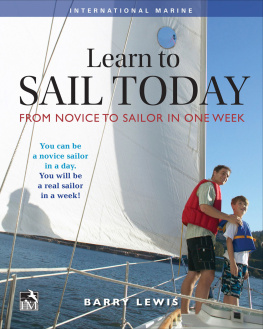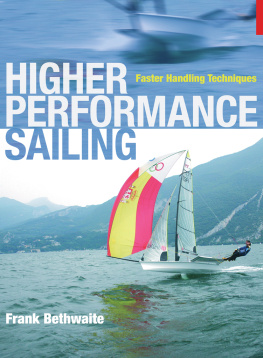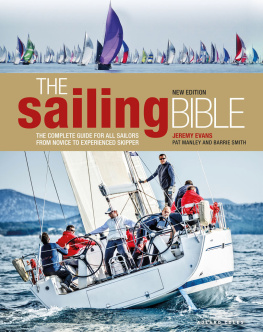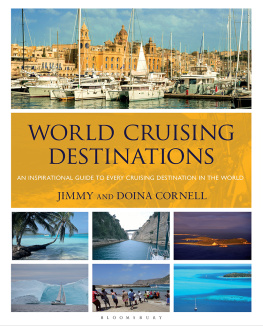WIND SENSE
To know the laws that govern the winds, and to know that you know them, will give you an easy mind ; otherwise you may tremble at the appearance of every cloud.
Joshua Slocum, Sailing Alone Around the World
Sailing is not a science that can be practiced with precision. It is an art, or at the least a craft, with its own medium. As an artist uses and understands light, you must understand the wind. It is the sailors medium.
In the beginning you need only know from where and how strong the wind is blowing. Without this youll go nowhere. Literally. But the essence of sailing lies not just in reacting to the wind; if you would be a sailor you must learn to read the wind and foretell what it will bring. It is a rare ability in the 21st century, but our marine forebears acquired a deep knowledge of the winds, and for good reason. Their lives depended on it. You will find some of this lore in the coming pages. To acquire a wind sense learn these few facts, and then start using your own natural abilities.
There is an old Irish saying that mans best friends and worst enemies are fire, rain, and wind. We cant deny that wind possesses its share of riddles, but the better you understand the laws that govern it, the less a mystery the wind will be when you are on the water.

Direction

By convention, winds are named for the quarter from which they blow. A wind blowing from the north toward the south is a north wind. But the winds direction is never steady, and as you sail youll need to keep track of what it is doing.
Clues to the wind are always around you. Waves are sculpted and pushed along by the wind, but only the ripples on the surface will show the winds direction. Larger waves and swells may have been generated hours or days ago by distant forces. Cats-pawsdelicate, rapidly moving ripples that crest at right angles to the wind and chase it along the surfacereveal the direction of an approaching gust. Look for leaves, sand, or anything that can be blown. Boats at anchor or on moorings can give clues, for they will swing to point into the wind unless otherwise influenced by currents. Light shallow boats are the best indicators. Curiously, the sky is the last place to look, the movement of high clouds having little to do with the wind down here at the bottom of the atmosphere.
Make your own indicators on the boat. Install a flag or specially made windvane (better for light winds) at the top of the mast. Tie telltales (made from yarn) to the shrouds as high up as possible.
You are your own best indicator. Face the winds general direction and turn your head slowly from side to side, noting the changing sensations on your skin and hair. There will be a difference in pressure, and temperature from evaporation, on each cheek until you are facing squarely into the breeze. Use your ears too. Even the slightest draft creates turbulence. Keep turning until the sound is the same in both.
If you practice sensing the wind on land as well as on the water, it will become second nature in a very short time.
Words of the Wind

UP/DOWN: A sailors world is divided into two halves: everything toward the wind and everything away from it. You face upwind by looking into the wind, and downwind by turning your back to it. Sailors shorten this to up or down. If you were told to bring her up, you would turn toward the wind; take her down means to turn away.
WINDWARD/LEEWARD: This is another way of saying up or down. Anything upwind of you is to windward, anything downwind is to leeward, which is often pronounced looard by some tradition-minded sailors.
WEATHER/LEE: Anything upwind of you is prefaced by the word weather. A weather shore gives protection from the wind, but the weather side of a boat is exposed to it. Anything downwind of you is prefaced by the word lee. A gale can blow you onto a lee shore, and you can get out of the wind by anchoring in the lee of a bold shore.
ON/OFF: Sailing on the wind means your course is in a windward direction, and you are either close-hauled or on a close reach. Sailing off the wind means you are headed in a leeward direction, and you are on a beam reach, broad reach, or running with the wind.

Land and the Wind

THE EFFECTS OF LAND
Winds coming off the land will always be more capricious than those that have reached you over open water. New Englands prevailing cool-weather northwesterlies can be maddeningly indecisive to a sailor used to the steadier southwesterlies of summer. And a blue-water ocean sailor may be at a loss to decipher wind directions on a lake, while the inland sailor may find the steadier winds of the open sea thoroughly uninteresting.
Large land features can produce their own wind systems. The notorious Santa Ana winds of Southern California are caused by inland desert air tumbling down the coastal mountains to the shore. Or winds can be funneled by the banks of a river or down a narrow tree-lined lake.
More important to most sailors are the smaller land features that affect the wind. Looking at this illustration you may get some clues as to why the winds where you sail seem irrational. Try to find wind funnels that compress and accelerate winds. Islands cause eddies that whirl about for great distances downwind. Cliffs have only a minor effect on winds blowing along their face, but cause radical changes to those blowing toward or over them. Solid objects blocking a wind, such as buildings or another boat, make wind shadowsareas of reduced wind speedthat can extend downwind for up to thirty times the height of the object. Bridges and other open barriers create wind flaws with baffling shifts. The mere passage of a wind over or through something is enough to alter it.
PREVAILING WINDS
The difference in temperatures at the equator and the poles, with warm air rising to be replaced by colder air, is the foundation of the worlds wind patterns. To this we add a deflecting effect from the Earths eastward rotation, the presence of relatively stationary areas of high and low pressure, and land-masses with their own localized wind machines to produce the prevailing winds of the world.
Between 30 and 50 degrees north and south latitude is the home of the westerlies. Just south of 30 degrees north, in the Gulf states and Florida, is the northern boundary of the northeast trade winds. This narrow buffer zone between two major wind systems is an area of calms and light variable winds known as the horse latitudes. Here early explorers were forced to jettison their horses, as food ran low while they sat becalmed waiting to hitch a downwind ride on the trade winds to the New World.

